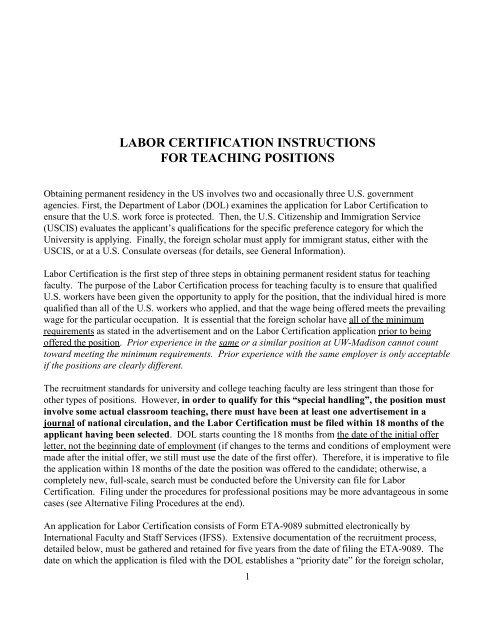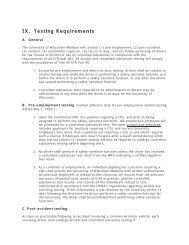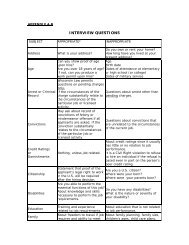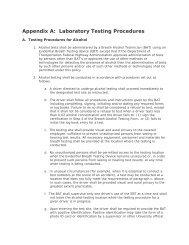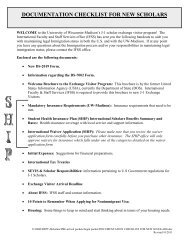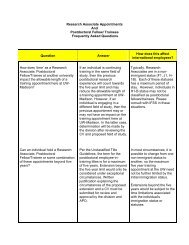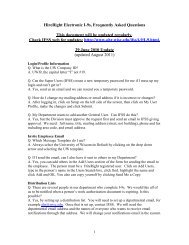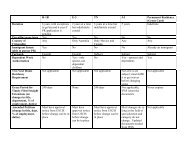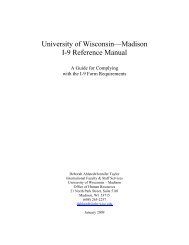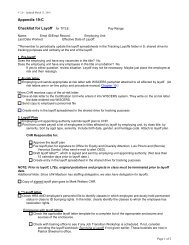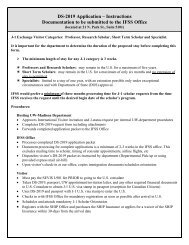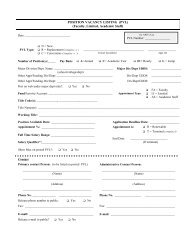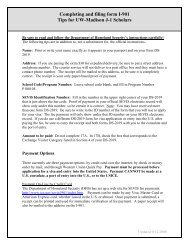Labor Certification for Teaching Faculty
Labor Certification for Teaching Faculty
Labor Certification for Teaching Faculty
Create successful ePaper yourself
Turn your PDF publications into a flip-book with our unique Google optimized e-Paper software.
LABOR CERTIFICATION INSTRUCTIONS<br />
FOR TEACHING POSITIONS<br />
Obtaining permanent residency in the US involves two and occasionally three U.S. government<br />
agencies. First, the Department of <strong>Labor</strong> (DOL) examines the application <strong>for</strong> <strong>Labor</strong> <strong>Certification</strong> to<br />
ensure that the U.S. work <strong>for</strong>ce is protected. Then, the U.S. Citizenship and Immigration Service<br />
(USCIS) evaluates the applicant’s qualifications <strong>for</strong> the specific preference category <strong>for</strong> which the<br />
University is applying. Finally, the <strong>for</strong>eign scholar must apply <strong>for</strong> immigrant status, either with the<br />
USCIS, or at a U.S. Consulate overseas (<strong>for</strong> details, see General In<strong>for</strong>mation).<br />
<strong>Labor</strong> <strong>Certification</strong> is the first step of three steps in obtaining permanent resident status <strong>for</strong> teaching<br />
faculty. The purpose of the <strong>Labor</strong> <strong>Certification</strong> process <strong>for</strong> teaching faculty is to ensure that qualified<br />
U.S. workers have been given the opportunity to apply <strong>for</strong> the position, that the individual hired is more<br />
qualified than all of the U.S. workers who applied, and that the wage being offered meets the prevailing<br />
wage <strong>for</strong> the particular occupation. It is essential that the <strong>for</strong>eign scholar have all of the minimum<br />
requirements as stated in the advertisement and on the <strong>Labor</strong> <strong>Certification</strong> application prior to being<br />
offered the position. Prior experience in the same or a similar position at UW-Madison cannot count<br />
toward meeting the minimum requirements. Prior experience with the same employer is only acceptable<br />
if the positions are clearly different.<br />
The recruitment standards <strong>for</strong> university and college teaching faculty are less stringent than those <strong>for</strong><br />
other types of positions. However, in order to qualify <strong>for</strong> this “special handling”, the position must<br />
involve some actual classroom teaching, there must have been at least one advertisement in a<br />
journal of national circulation, and the <strong>Labor</strong> <strong>Certification</strong> must be filed within 18 months of the<br />
applicant having been selected. DOL starts counting the 18 months from the date of the initial offer<br />
letter, not the beginning date of employment (if changes to the terms and conditions of employment were<br />
made after the initial offer, we still must use the date of the first offer). There<strong>for</strong>e, it is imperative to file<br />
the application within 18 months of the date the position was offered to the candidate; otherwise, a<br />
completely new, full-scale, search must be conducted be<strong>for</strong>e the University can file <strong>for</strong> <strong>Labor</strong><br />
<strong>Certification</strong>. Filing under the procedures <strong>for</strong> professional positions may be more advantageous in some<br />
cases (see Alternative Filing Procedures at the end).<br />
An application <strong>for</strong> <strong>Labor</strong> <strong>Certification</strong> consists of Form ETA-9089 submitted electronically by<br />
International <strong>Faculty</strong> and Staff Services (IFSS). Extensive documentation of the recruitment process,<br />
detailed below, must be gathered and retained <strong>for</strong> five years from the date of filing the ETA-9089. The<br />
date on which the application is filed with the DOL establishes a “priority date” <strong>for</strong> the <strong>for</strong>eign scholar,<br />
1
which may be important later in determining how long the final step of the permanent residence process<br />
will take.<br />
Processing an application <strong>for</strong> <strong>Labor</strong> <strong>Certification</strong> by the DOL is supposed to take 45-60 days, unless the<br />
application is selected <strong>for</strong> audit, although recently they have been taking several months even without an<br />
audit. Applications may be selected <strong>for</strong> a random audit, or they may be audited if DOL feels the job<br />
requirements are too restrictive, or if there is a combination of occupations required or acceptable <strong>for</strong> the<br />
position or <strong>for</strong> other unspecified reasons. Obtaining permanent resident status from submission of the<br />
application <strong>for</strong> <strong>Labor</strong> <strong>Certification</strong> to approval of the adjustment of status petition currently takes at least<br />
one to two years. Processing times vary considerably and can change dramatically in a short time.<br />
NOTES<br />
Graduates of <strong>for</strong>eign medical schools who will be involved in direct patient care, in addition to their<br />
teaching and research activities, must meet specific credential and license requirements. IFSS can<br />
provide detailed in<strong>for</strong>mation.<br />
Once <strong>Labor</strong> <strong>Certification</strong> is approved, the University will file an application <strong>for</strong> immigrant<br />
classification under the second employment based category <strong>for</strong> “members of the professions holding<br />
advanced degrees.” The individual must have a degree beyond a bachelor’s, or a bachelor’s plus at<br />
least five years of post-baccalaureate, progressive work experience in the specialized field. If a<br />
doctorate is usually required <strong>for</strong> the profession, the individual must have a doctorate. There are no<br />
experience equivalencies <strong>for</strong> a doctorate.<br />
UW-MADISON PROCEDURES<br />
If the employing department has already recruited extensively <strong>for</strong> the position, including an<br />
advertisement in a national professional journal, and the candidate was selected within eighteen months<br />
of the expected filing of the <strong>Labor</strong> <strong>Certification</strong> application, the University can proceed with the<br />
application.<br />
The Department Administrator and the applicant should attend one of the regular workshops on<br />
obtaining permanent residence presented by IFSS. At the workshop, detailed in<strong>for</strong>mation is given on the<br />
process, and the necessary <strong>for</strong>ms and instructions are reviewed.<br />
The application is filed electronically through a DOL program called PERM. IFSS has obtained<br />
authorization from the DOL to file <strong>for</strong> <strong>Labor</strong> <strong>Certification</strong> on behalf of UW-Madison and has a Personal<br />
Identification Number <strong>for</strong> such filings. IFSS is the only office that can file <strong>for</strong> <strong>Labor</strong> <strong>Certification</strong> <strong>for</strong><br />
UW-Madison employees.<br />
2
Overview<br />
The following is an overview of the steps involved in filing <strong>for</strong> permanent residence based on a <strong>Labor</strong><br />
<strong>Certification</strong>. These steps are done after the search has concluded and an offer and acceptance of the<br />
position has occurred.<br />
Academic Department:<br />
___ Submits to IFSS the signed Dean’s Authorization and Department Request <strong>for</strong>ms, the<br />
Prevailing Wage Determination <strong>for</strong>m, the ETA-9089 worksheet, and the Beneficiary In<strong>for</strong>mation<br />
Form, plus copies of all recruitment documentation (see <strong>Labor</strong> <strong>Certification</strong> Forms and<br />
Documentation below), except <strong>for</strong> the CV of the rejected candidates.<br />
___ Between 30 and 180 days prior to filing the ETA-9089, the department reposts a copy of<br />
PVL with the DOL Notice Requirement in two places in the Department <strong>for</strong> 10 (two months <strong>for</strong><br />
faculty positions) consecutive working days (see Posting Requirements). Note: This must be<br />
done early enough to permit filing the ETA-9089 within the 18 month deadline. The ETA-<br />
9089 cannot be filed less than 30 days after the end of the PVL posting.<br />
International <strong>Faculty</strong> & Staff Services:<br />
___ Submits the prevailing Wage Request <strong>for</strong>m to the US Department of <strong>Labor</strong> (DOL). Once<br />
DOL makes its determination, IFSS reviews Prevailing Wage Determination with Department to<br />
ensure compliance.<br />
___ Completes and submits ETA-9089 electronically to DOL when all supporting<br />
documentation is received from the academic department.<br />
Department of <strong>Labor</strong><br />
___ Certifies or denies ETA-9089 and returns, or sends an audit letter.<br />
Academic Department<br />
___Beneficiary signs certified ETA-9089 immediately upon receipt from DOL.<br />
___Prepares and submits <strong>for</strong>m I-140 to IFSS along with a check <strong>for</strong> $580 from the employee<br />
payable to US Department of Homeland Security <strong>for</strong> the filing fee and the supporting<br />
documentation (see below). Per UW policy, the individual must pay the filing fee, not the<br />
department.<br />
NOTE: The I-140 must be filed within 180 days of the date the ETA-9089 was certified by the<br />
Department of <strong>Labor</strong>. Failure to file within the deadline will result in the automatic cancellation<br />
of the <strong>Labor</strong> <strong>Certification</strong>.<br />
International <strong>Faculty</strong> and Staff Services<br />
___Signs ETA-9089<br />
___Reviews I-140, prepares application packet and submits to USCIS.<br />
3
Foreign Scholar – Adjustment of Status or Consular Processing<br />
The final step in the permanent residency process is the responsibility of the <strong>for</strong>eign scholar, who must<br />
gather documentation and submit it to USCIS <strong>for</strong> “Adjustment of Status” to permanent resident, or<br />
submit an application <strong>for</strong> an immigrant visa to a U.S. consulate abroad <strong>for</strong> “consular processing.” In<br />
most cases, <strong>for</strong>eign scholars at UW-Madison will apply <strong>for</strong> Adjustment of Status, (file the I-485) since<br />
they are already present in the U.S. Scholars may be able to file their application <strong>for</strong> adjustment<br />
concurrently with the University’s I-140, later with a copy of the I-140 receipt notice, or after the I-140<br />
has been approved. The priority date, which was established when the <strong>Labor</strong> <strong>Certification</strong> application<br />
was filed with the DOL, determines if the application <strong>for</strong> Adjustment of Status can be filed immediately,<br />
or if there is a waiting period. IFSS can advise the scholar about cut-off dates, or the scholar can check<br />
the Visa Bulletin on the State Department web site at: http://travel.state.gov. For complete in<strong>for</strong>mation<br />
on this step of the process, see “Adjustment of Status” under:<br />
http://www.ohr.wisc.edu/ifss/PR/index.htm.<br />
RECRUITMENT PROCEDURES<br />
Although university and college teaching faculty benefit from “special handling,” all of the following<br />
recruitment procedures must be followed in order to meet the DOL regulatory requirements.<br />
At least one advertisement must be placed in a national professional journal, which states the job title,<br />
duties and requirements. Electronic AND print ads must both meet the following two requirements:<br />
<br />
<br />
The advertisement must be in a website or publication that is NATIONAL in scope. Websites or<br />
publications that only list job opportunities in a specific region probably do not qualify to satisfy<br />
the PERM requirements.<br />
The publication or website must be that of a PROFESSIONAL JOURNAL, meaning that the<br />
journal which publishes the ad must regularly offer articles with scholarly or professional content<br />
in addition to job listings in at least one of its <strong>for</strong>mats.<br />
Electronic advertisements must also meet the following two requirements, which do not apply to print<br />
ads:<br />
<br />
<br />
Electronic advertisements must be posted <strong>for</strong> a MINIMUM OF 30 CALENDAR DAYS.<br />
The START AND END DATES of the electronic advertisement must be documented. The gold<br />
standard of evidence <strong>for</strong> this requirement would be computer printouts of the advertisement from<br />
a web browser showing the URL and the date. Those printouts would ideally be made on both<br />
the day the ad was posted and the day the ad was taken down. There may be other types of<br />
acceptable evidence if this is infeasible. For print ads, tear sheets are still the preferred method<br />
of proof.<br />
4
Just a reminder that the folks who evaluate our permanent labor certifications at DOL are not specialists<br />
in higher education, and certainly not specialists in any particular academic field. The only publication<br />
they are all familiar with is the Chronicle of Higher Education. Any other "national professional<br />
journal" that is submitted, will be subject to undue and possibly unfair skepticism about its national<br />
scope and professional/scholarly content. There<strong>for</strong>e, I would encourage searches to continue to make<br />
use of the Chronicle's electronic advertisements, especially because those ads are significantly cheaper<br />
than those in the print edition.<br />
The advertisement should include the same in<strong>for</strong>mation as the Position Vacancy Listing (PVL). The<br />
copy must include the name and dates of publication.<br />
2. All applications must be reviewed in accordance with normal faculty search procedures and the most<br />
qualified candidate must be selected.<br />
3. Post-recruitment postings must be conducted between 30-180 days prior to filing the ETA-9089 (see<br />
below).<br />
Prevailing Wage Determination<br />
Requirements: The Department must pay the international faculty member 100% of the prevailing<br />
wage or the actual wage offered, whichever is higher. The prevailing wage is the weighted average<br />
salary paid to all persons equally employed in the area of intended employment. The University must<br />
use the prevailing wage determinations provided by the US Department of <strong>Labor</strong>. The Department of<br />
<strong>Labor</strong> can investigate complaints and review the documentation to ensure compliance with the wage<br />
requirements.<br />
Department Procedures: In order to complete the process <strong>for</strong> determining the prevailing wage, the<br />
Department must:<br />
Type the in<strong>for</strong>mation on the enclosed Prevailing Wage Request <strong>for</strong>m. The <strong>for</strong>m is also available on<br />
the IFSS web site at: http://www.ohr.wisc.edu/ifss/PR/index.htm. Remember to use the MINIMUM<br />
requirements to fill the position, not the individual’s qualifications.<br />
Submit to IFSS.<br />
IFSS will check the job requirements and duties against the Specific Vocational Preparation (SVP)<br />
shown in the O*Net Job Zones to be sure that the requirements stated by the Department on the <strong>for</strong>m<br />
are those normally required <strong>for</strong> the occupation and do not exceed the SVP. If the requirements do<br />
exceed the SVP, IFSS will contact the Department <strong>for</strong> clarification. The department would have to<br />
document business necessity by showing that “the job duties and requirements bear a reasonable<br />
relationship to the occupation in the context of the employer’s business and are essential to per<strong>for</strong>m<br />
the job in a reasonable manner.” DOL will reject an application if others have been hired <strong>for</strong> a similar<br />
position with less than the stated requirements or if the beneficiary gained experience in a substantially<br />
5
similar position with the employer prior to being offered the position <strong>for</strong> which the <strong>Labor</strong> <strong>Certification</strong><br />
is being filed.<br />
Processing In<strong>for</strong>mation: IFSS will submit the Prevailing Wage Request <strong>for</strong>m to the US Department of<br />
<strong>Labor</strong> <strong>for</strong> the determination of the prevailing wage. Each prevailing wage determination is made<br />
individually by DOL; there<strong>for</strong>e, until a prevailing wage request <strong>for</strong>m is submitted to DOL, there is no<br />
method to predict the prevailing wage level <strong>for</strong> each title within a department. The department must pay<br />
100% of the prevailing wage or the offered wage, whichever is higher. In the event that the prevailing<br />
wage determination is higher than the offered salary, IFSS will contact the department immediately.<br />
Any appeal of the prevailing wage determination must be filed within 30 days of receipt of the original<br />
determination.<br />
The prevailing wage determination is valid <strong>for</strong> a period of between 90 days and one year, whatever is<br />
assigned by DOL. The ETA-9089 must be filed within the validity period of the Prevailing Wage<br />
Determination.<br />
POST-RECRUITMENT POSTING REQUIREMENTS<br />
Between 30 and 180 days prior to filing the ETA-9089, the employer must give notice of its intent to file<br />
the application and be able to document that such notice was provided by posting such notice:<br />
at an appropriate location (e.g., the location where other job opportunities are posted or<br />
where required wage and hour or OSHA notices are posted) on the employment premises<br />
<strong>for</strong> at least 10 consecutive business days; and<br />
by publishing the notice in any electronic in-house media used <strong>for</strong> the recruitment of<br />
similar positions in the employer's organization<br />
Posting must be conducted in accordance with Department of <strong>Labor</strong> regulations, even though the<br />
position has been filled already by the person <strong>for</strong> whom we are applying. The print posting should<br />
consist of the original Position Vacancy Listing (PVL), with the following statement typed either onto<br />
the face of the PVL or on a separate sheet of paper that is attached to the PVL. The text of the statement<br />
should read:<br />
“A competitive recruitment and selection process was conducted <strong>for</strong> this employment opportunity and a<br />
U.S. worker was not selected. An application <strong>for</strong> Alien Employment <strong>Certification</strong> is being filed on<br />
behalf of an alien to fill the employment opportunity. Anyone with documentary evidence relative to the<br />
application, or available workers, wages and/or working conditions, may contact the Regional Certifying<br />
Office of the Department of <strong>Labor</strong> at the following address:<br />
U.S. Department of <strong>Labor</strong><br />
Employment and Training Administration<br />
Foreign <strong>Labor</strong> <strong>Certification</strong> National Processing Center<br />
Harris Tower<br />
233 Peachtree Street, Suite 410<br />
Atlanta, GA 30303<br />
6
Phone: 404-893-0101<br />
Fax: 404-893-4642”<br />
The PVL and accompanying statement must be posted in two conspicuous locations in the hiring<br />
Department <strong>for</strong> at least ten consecutive working days in a place that is clearly visible and unobstructed.<br />
In addition, the PVL must be re-posted on the OHR web during the same time frame, 30-180 days prior<br />
to filing the ETA-9089. The Department will need to create a new PVL with the exact same text as the<br />
original one under which the beneficiary was hired. In the “Additional In<strong>for</strong>mation” section on the PVL,<br />
the Department must type in the same text as above, including the address. In the “Comments” section,<br />
the Department should advise OHR that this PVL is being posted in connection with an application <strong>for</strong><br />
<strong>Labor</strong> <strong>Certification</strong> and that it is to be posted <strong>for</strong> the normal period of time <strong>for</strong> such a position (usually 2<br />
months). It is the Department’s responsibility to monitor the posting time. Upon the completion of the<br />
posting time, the Department should print a copy of the on-line posting and send an email to Angie<br />
Rosas, arosas@ohr.wisc.edu, requesting that she remove the PVL. At the end of the posting period,<br />
remove the PVL and statement, and document the results of the posting in accordance with the “Sample<br />
Letter <strong>for</strong> Department to Certify that Position Was Properly Posted.” If no inquiries were received,<br />
indicate that in the letter. If any inquiries were received, they should be referred to the DOL. Inquires<br />
from individuals who think the position is still vacant should not be referred to the DOL. The<br />
individuals should be told the position is filled. This posting is not a part of the recruitment process, but<br />
rather notification of the filing of the <strong>Labor</strong> <strong>Certification</strong>. The letter must be signed by the person with<br />
hiring authority who will sign the ETA-9089 worksheet. Please submit the letter and copies of both<br />
postings to IFSS.<br />
LABOR CERTIFICATION FORMS AND DOCUMENTATION<br />
1. Form ETA-9089 is filed electronically by IFSS. The <strong>for</strong>m must be signed immediately upon<br />
certification by IFSS and the beneficiary.<br />
2. All recruitment documentation, which includes:<br />
a signed statement from the Chair outlining in detail the complete recruitment procedures<br />
undertaken, including the total number of applicants and the specific, lawful, job-related reasons<br />
why each U.S. resident or citizen who applied <strong>for</strong> the position was not as qualified as the<br />
beneficiary, based on the advertised education and experience requirements (incomplete file is<br />
not acceptable). This should be in the <strong>for</strong>m of a list as an addendum, identifying each applicant<br />
by name, and the reason(s) <strong>for</strong> rejection.<br />
a final report of the body making the recommendation of selection of the beneficiary (the Search<br />
Committee) after the completion of the process.<br />
a copy of at least one advertisement placed in a national professional journal, giving the name<br />
and dates of publication and which states the job title, duties and requirements.<br />
CV and application materials of all applicants, including the beneficiary. NOTE: IFSS only<br />
needs the application materials from the beneficiary, not all of the other applicants. The<br />
department must retain all other applications <strong>for</strong> five years. See Document Retention below.<br />
7
evidence of all other recruitment sources used such as letters to other universities, postings at<br />
conferences, electronic web postings, emails etc. Attach copies of these other recruitment<br />
ef<strong>for</strong>ts, including the date(s) the postings were sent, conference was held or emails were sent.<br />
The exact dates of the advertisements must be given to IFSS.<br />
completed paper and electronic postings and statements regarding postings. See Post-<br />
Recruitment Posting Requirements below.<br />
3. The initial offer letter (and any subsequent amendments).<br />
4. A written statement attesting to the degree of the beneficiary’s educational or professional<br />
qualifications and academic achievements. This should consist of a letter from the Chair describing the<br />
beneficiary’s education and experience, supported by the CV and a copy of all pertinent degree(s),<br />
certificates or licenses (if applicable), with translations of all documents that are not in English,<br />
including those that are in Latin (see Translations Guidelines below). If the diploma does not indicate<br />
the field in which the degree was granted, or if the field is not obviously relevant to the position the<br />
scholar will be filling, a set of transcripts should also be included, with a translation as necessary. If the<br />
beneficiary obtained his education outside the United States or Canada, it is recommended that a<br />
credential evaluation be done. More in<strong>for</strong>mation about such an evaluation can be found at<br />
www.naces.org.<br />
DOCUMENT RETENTION<br />
All documentation must be retained <strong>for</strong> at least five years from the date of filing the ETA-9089.<br />
IFSS strongly suggests that it be retained in one place, to facilitate a response in case of an audit. We are<br />
only given thirty (30) days to respond to an audit request, so a speedy response is essential. The<br />
document retention file must include:<br />
1. a copy of the signed and certified ETA-9089<br />
2. a copy of the Prevailing Wage Determination<br />
3. documentation of the paper and electronic PVL postings<br />
4. documentation that the beneficiary met the minimum job requirements when hired<br />
5. all recruitment documentation (see above)<br />
6. a copy of the initial offer letter and any subsequent revisions.<br />
IFSS retains a copy of all documentation except the application materials from all of the rejected<br />
candidates. These must be retained by the Department <strong>for</strong> the required five years.<br />
I-140 SUPPORTING DOCUMENTATION<br />
Once the <strong>Labor</strong> <strong>Certification</strong> has been certified, the University must file <strong>for</strong>m I-140 with USCIS within<br />
180 days of the date it was certified. IFSS will attach the original certified <strong>Labor</strong> <strong>Certification</strong> to the I-<br />
140 along with:<br />
8
1. a copy of the initial offer letter, and any subsequent revisions,<br />
2. a copy of the beneficiary’s CV,<br />
3. a copy of the diploma(s), and a transcript if the field of study is not on the diploma,<br />
4. a copy of the credential evaluation if necessary,<br />
5. a copy of the first page of the beneficiary’s publications,<br />
6. a copy of all recommendation letters received during the search process,<br />
7. evidence of the University’s existence and ability to pay the prevailing wage or offered wage; and<br />
8. $580 check payable to the US Department of Homeland Security from the employee.<br />
NOTE: The I-140 must be filed within 180 days of the date the ETA-9089 was certified by the<br />
Department of <strong>Labor</strong>. Failure to file within the deadline will result in the automatic cancellation<br />
of the <strong>Labor</strong> <strong>Certification</strong>.<br />
TRANSLATIONS GUIDELINES<br />
Translations do not need to be done by a professional translating service, nor do they need to be<br />
notarized. They should be accompanied by a statement from the translator indicating his/her<br />
qualifications <strong>for</strong> doing the translation. The <strong>for</strong>eign scholar should NOT do the translation, nor should<br />
an immediate family member. The translator must sign and date the translation. The following<br />
statement must be on the translation: “I certify that I am fluent (conversant) in English and _________<br />
and that the above/attached document is an accurate translation of the document attached entitled<br />
______________________________.”<br />
ALTERNATIVE FILING PROCEDURES<br />
Colleges and universities have the option of filing either under the special handling procedures <strong>for</strong><br />
college and university teachers, or under the regular procedures <strong>for</strong> professional positions. In almost all<br />
instances, it is better to file under the special handling procedures. Filing under the professional<br />
procedures would require a new advertisement and recruitment process. However, if the Department<br />
missed the 18 month deadline <strong>for</strong> faculty special handling, the professional procedures might be<br />
beneficial. If this occurs, the Department should contact IFSS to discuss the process and develop a plan.<br />
The following is a brief summary of the process:<br />
<br />
<br />
<strong>for</strong> professional positions, the employer must conduct the recruitment within 6 months of<br />
filing the application.<br />
a job order and two print advertisements are mandatory parts of the recruitment and<br />
they must be conducted at least 30 days, but not more than 180 days, be<strong>for</strong>e filing the<br />
application.<br />
o the job order is placed with State of Wisconsin, Department of Work<strong>for</strong>ce<br />
Development <strong>for</strong> a period of 30 days<br />
9
• https://jobcenterofwisconsin.com/<br />
o the advertisements must be placed in a newspaper of general circulation on two<br />
different Sundays, or the employer may, in lieu of one of the Sunday<br />
advertisements, place an advertisement in a professional journal<br />
o the advertisements must:<br />
• include the employer's name<br />
• direct applicants to the employer<br />
• provide a specific description of the vacancy<br />
• indicate the geographic area of employment and describe any travel<br />
requirements<br />
• contain a wage rate at least equal to the prevailing wage rate<br />
• not contain job duties or requirements which exceed those listed in the<br />
ETA-9089<br />
• not contain wages or terms and conditions of employment that are less<br />
favorable than those offered the alien<br />
the employer also must select three additional recruitment steps from the following<br />
alternatives (note that only one of the additional steps may take place within 30 days of<br />
filing and none of the steps may have taken place more than 180 days prior to filing):<br />
o job fairs<br />
o employer's web site<br />
o job search web site other than the employer's web site<br />
o on-campus recruiting<br />
o trade or professional organizations<br />
o private employment firms (headhunters)<br />
o employee referral program with incentives<br />
o campus placement offices<br />
o local and ethnic newspapers<br />
o radio and television advertisements<br />
the employer must prepare a recruitment report signed by the employer's representative<br />
describing:<br />
o the recruitment steps taken and the results achieved<br />
o the number of hires<br />
o the number of U.S. workers rejected, categorized by the lawful job-related reasons<br />
<strong>for</strong> such rejections<br />
a U.S. worker is able and qualified <strong>for</strong> the job if the worker can acquire the necessary<br />
skills during a reasonable period of on-the-job training<br />
PERM lc.dir 10/2012<br />
10


